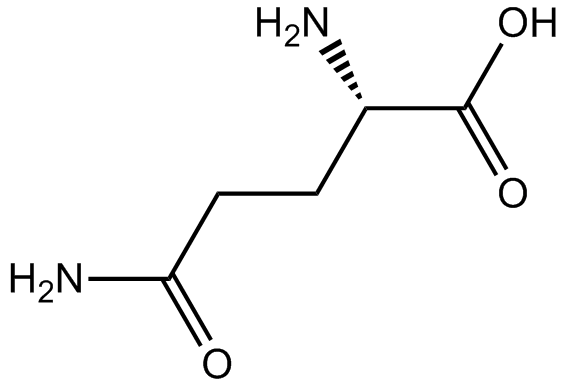L-Glutamine (Synonyms: L-Gln, (+)-Glutamine, (S)-2,5-Diamino-5-Oxopentanoic Acid, NSC 27421) |
| Katalog-Nr.GC17498 |
L-Glutamin (L-GlutaminsÄure-5-amid) ist eine nicht-essentielle AminosÄure, die im ganzen KÖrper reichlich vorhanden und an vielen Stoffwechselprozessen beteiligt ist.
Products are for research use only. Not for human use. We do not sell to patients.

Cas No.: 56-85-9
Sample solution is provided at 25 µL, 10mM.
L-Glutamine is a non-essential amino acid present abundantly throughout the body and is involved in gastrointestinal disorders.Target: mGluRGlutamine (abbreviated as Gln or Q) is one of the 20 amino acids encoded by the standard genetic code. It is not recognized as an essential amino acid, but may become conditionally essential in certain situations, including intensive athletic training or certain gastrointestinal disorders. Its side-chain is an amide formed by replacing the side-chain hydroxyl of glutamic acid with an amine functional group, making it the amide of glutamic acid. Its codons are CAA and CAG. In human blood, glutamine is the most abundant free amino acid, with a concentration of about 500-900 μmol/L. Glutamine is synthesized by the enzyme glutamine synthetase from glutamate and ammonia. The most relevant glutamine-producing tissue is the muscle mass, accounting for about 90% of all glutamine synthesized. Glutamine is also released, in small amounts, by the lung and the brain. Although the liver is capable of relevant glutamine synthesis, its role in glutamine metabolism is more regulatory than producing, since the liver takes up large amounts of glutamine derived from the gut. The most eager consumers of glutamine are the cells of intestines, the kidney cells for the acid-base balance, activated immune cells, and manycancer cells. In respect to the last point mentioned, different glutamine analogues, such as DON, Azaserine or Acivicin, are tested as anticancer drugs.
References:
[1]. Brosnan JT. Interorgan amino acid transport and its regulation. J Nutr. 2003 Jun;133(6 Suppl 1):2068S-2072S.
[2]. Newsholme P, et al. Glutamine and glutamate as vital metabolites. Braz J Med Biol Res. 2003 Feb;36(2):153-63. Epub 2003 Jan 29.
[3]. Newsholme P. Why is L-glutamine metabolism important to cells of the immune system in health, postinjury, surgery or infection J Nutr. 2001 Sep;131(9 Suppl):2515S-22S; discussion 2523S-4S.
Average Rating: 5 (Based on Reviews and 3 reference(s) in Google Scholar.)
GLPBIO products are for RESEARCH USE ONLY. Please make sure your review or question is research based.
Required fields are marked with *




















